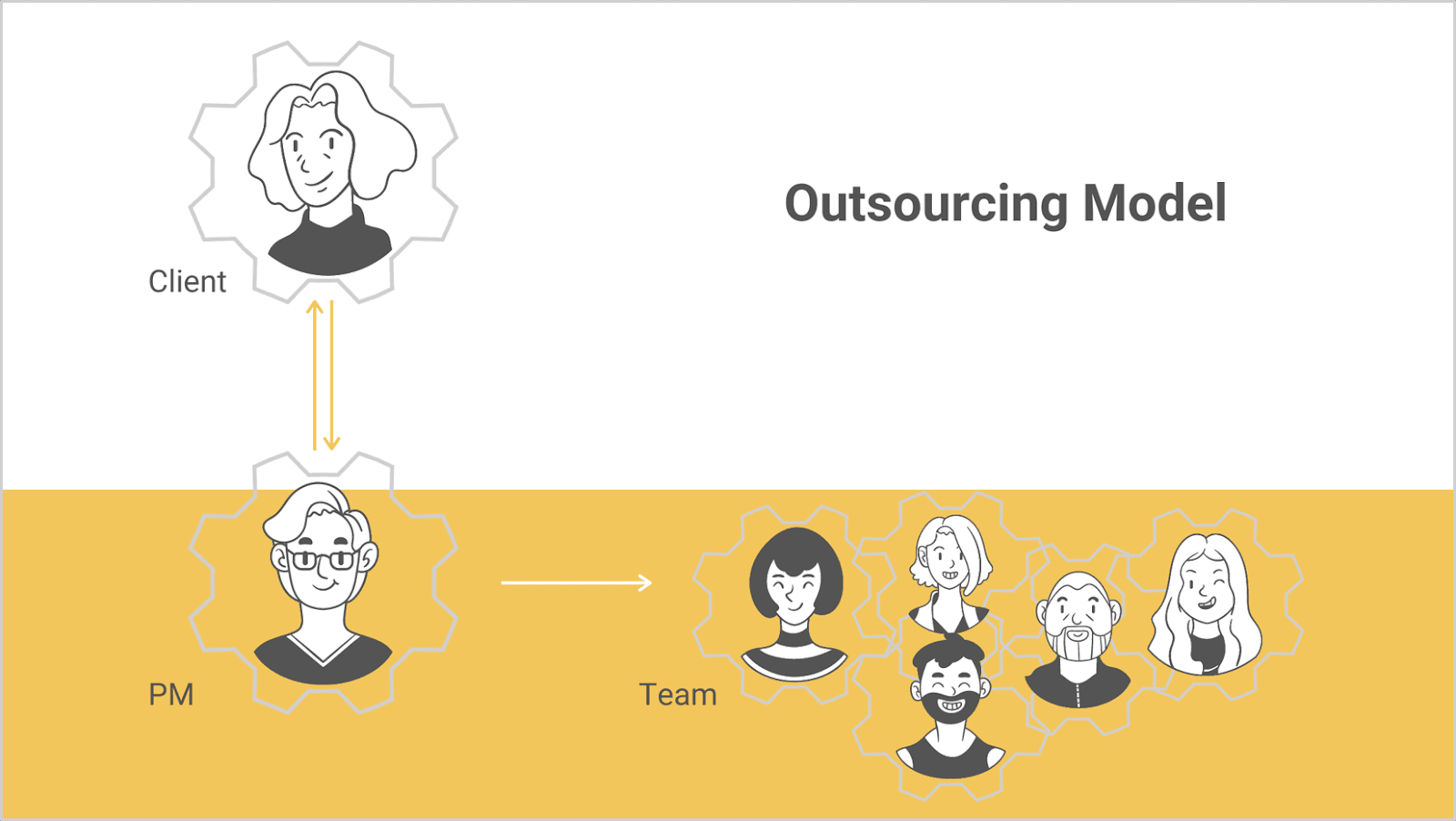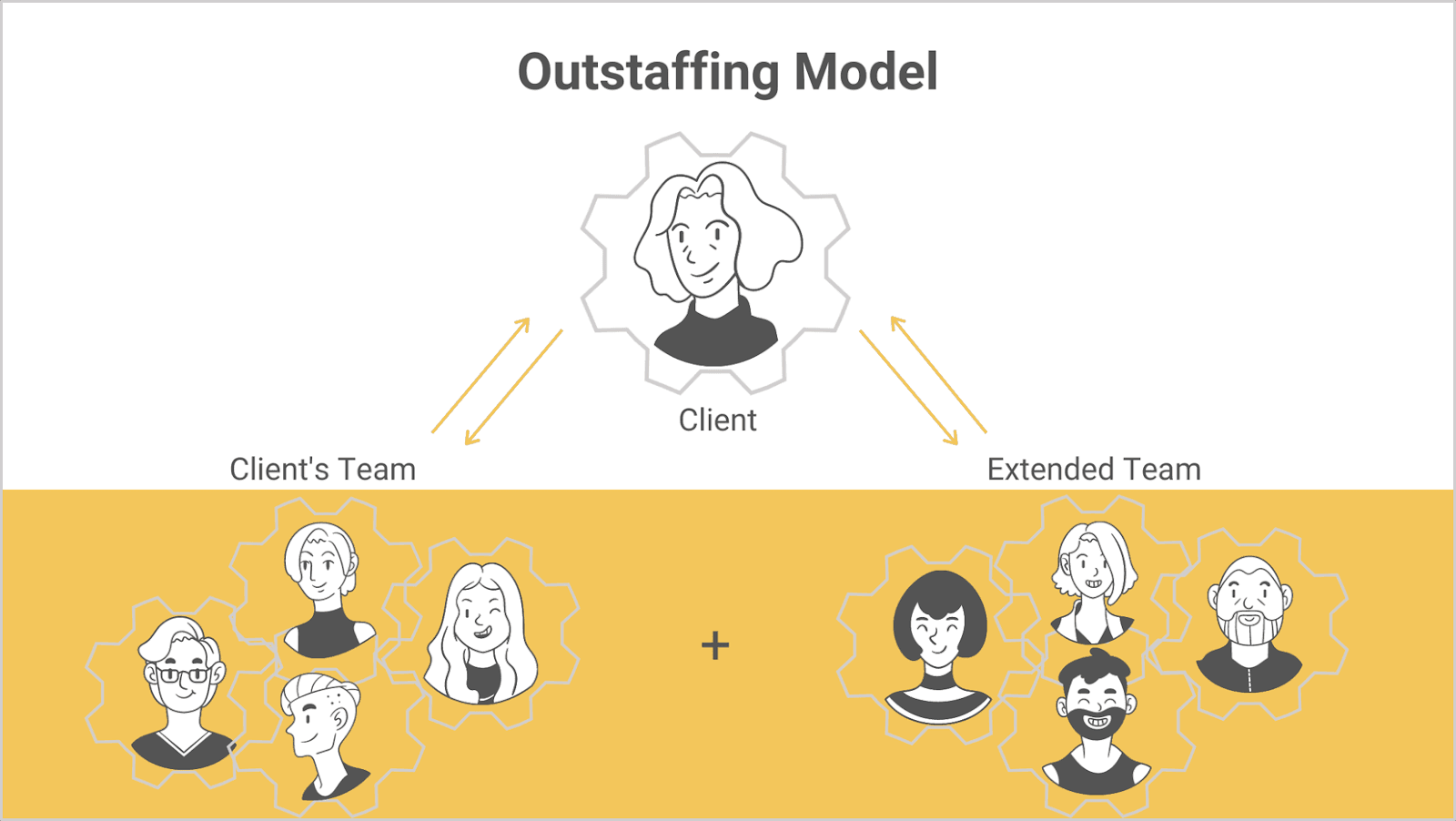
Outsourcing vs Outstaffing in Software Development. Which Model to Choose?
Outsourcing and outstaffing are widely adopted and recognized practices. By using them, you can improve development, reduce costs, and benefit from the expertise of highly skilled IT professionals.
While these concepts are widespread, they can sometimes be confusing. If you want to explore these models in more detail or select the one that suits your company, read our article. We will reveal the aspects of these concepts and also tell you how to apply them in practice without any risk.
What Is the Essence of Outsourcing Software Development?
Outsourcing is a project or function assignment to a third party that has resources to perform the task, such as a qualified team and equipment. This can mean creating a web or mobile application, developing a website, and so on. This approach is an alternative to creating an in-house department. Also, it provides opportunities to free up existing resources and focus on new areas of professional activity or develop those that require additional attention.
So, this practice means that the organization providing a service in this way takes over the work in full. For example, if this is an app, they will complete everything from specifications to maintenance. And by choosing to outsource, you will most likely interact with the manager of the hired team. The standard model looks like this.

Now let’s consider the main advantages and disadvantages of outsourcing development.
Pros
- Saving budget. Hiring an outsourcing team is cheaper than recruiting your own staff.
- No effort in hiring and managing staff. You get easy access to top-notch IT specialists without burdening yourself with HR issues.
- Access to global expertise. Since the work can be carried out in a remote format, you can team up with experts of any level, wherever they are.
- Less management burden. A good advantage of outsourced developers is that you do not need to manage them. Nor do you need to be a techie to delve into the code or technology used. But you can easily follow the workflow in cooperation with the hired team manager.
- Unnecessary to create documentation. Your contractor manages and completes all project data. You receive documentation upon completion of work, along with the source code and the deployed product.
- Quick start. If you're short on time, getting started with a remote company can be much faster than recruiting people for your own team.
Cons
- Workflow efficiency. Since you are not in direct contact with the team, it can be difficult to gauge the level and pace of work on tasks. Quality and process manuals can help with this.
- Communication efficiency. A remote contact must take into account time differences and other limitations due to distance. So, at the beginning of the project, it is necessary to establish suitable interaction methods in order to make the workflow efficient and smooth.
As we can see, the advantages of outsourcing software development are much greater than the disadvantages, which, moreover, can be solved without any particular issue.
What Is the Essence of Outstaffing Software Development?
Outstaffing is a model in which a team or a single specialist essentially performs a job for a client but works for an outstaff agency. In such conditions, the client controls the entire scope of work and also leads the team himself. The outstaff company as an employer undertakes to provide equipment and salary. In turn, the client sets tasks and monitors the results.
Customers may prefer this approach when they already have a technical team, but lack experts, so the problem cannot be completely solved in-house. Basically, the outstaffing model looks like this.

Let's look at the benefits of outstaffing development as well as its drawbacks.
Pros
- Saving budget. It's even easier to save money than with the previous approach. In comparison, outstaffing payouts are much lower.
- No care about salaries. You do not have to worry about employee payments.
- Staff scalability. You can freely change the size of the staff you hire.
- Complete authority. The entire work is under your strict supervision.
- Quick start. As with the previous model, you can get started faster by contacting an outstaffing agency.
Cons
- Management burden. You have full responsibility over the extended team, project decisions, and code. So, it is best to have a tech-savvy expert or even several in your company.
- Communication efficiency. Here the team also requires established communication rules.
Now let's summarize the battle of outstaffing development versus outsourcing one.
Outstaffing Vs Outsourcing Software Development
So, the biggest difference between outsourcing versus outstaffing development is who plays the role of manager over the team performing your assignments. Typically, for outsourcing, this role is taken on by a manager who is a part of the team you are hiring. On the other hand, the outstaff model only works when the client controls the extended team. The CTO or Product Owner may be able to do this, but either way, it's someone from your company.
Let's take a look at outstaffing versus outsourcing comparisons according to various factors. So you will once again formulate for yourself the pros and cons of hiring outstaffing versus outsourcing teams.
Outsourcing vs Outstaffing Difference
| Outsource | Outstaff | |
| Scope of work | Usually, the customer completely entrusts work to the outsourcing team and expects to receive a turnkey project. | More often the customer submits isolated tasks that his internal team finds difficult to solve. |
| Management | The customer cannot personally lead professionals working on the project. | .The customer leads an extended team personally. |
| Price | Rates are higher than with outstaffing. | The customer can spend less since all performance is controlled by himself. |
| Payout | Contractors perform on the pay-per-interval basis. | According to the contract, experts receive a monthly salary. |
| Needed technical skills | In volume to formulate requirements for future product. | Large enough to directly manage a team of IT professionals. |
Our Model of Work
We at Gearheart provide outsourcing services and use an agile workflow based on Scrum. Our team consists of carefully selected professionals who have been working for the company for a long time. As we have built a clear workflow and always adhere to certain standards in work, we never involve freelancers in projects. Also, we do not transfer our employees to project teams of clients under their direct control. Instead, we form a dedicated team and manage employees. This guarantees the clients a clear and transparent workflow, while they can focus on solving their business problems. At the same time, our customers work in close cooperation with us. They don't have to be technicians, as they can rely on us. But they easily control the project, make comments and edits, ask questions, and receive full reporting, since they have access to any tool or project management system we use. Сonvenient communication rules are also formed. We believe that clients, if necessary, should be able to communicate not only with the manager but also with any member of the team, whether in Slack or on general calls.
Conclusion: Which One Works Best for You
You can decide based on the needs of your business and the required technical component, and it doesn't matter whether you have a mature business or a startup. If your company is not technically oriented and there are no in-house experts who could lead the development team, outsourcing is more suitable for you. In case you have your own staff but need to work with remote specialists and build processes, then you can turn to outstaffing.
Here is a quick guide to help you estimate conditions and make the choice towards outsource or outstaff development.
| I want a turnkey project. | I want to assign some regular work, but not the whole project. |
| My team is not tech-savvy. | I am well versed in IT to manage a team. |
| I want to transfer control. | I do not agree to delegate authority. |
| Wow, outsourcing is a notable solution! | Wow, outstaffing is a notable solution! |
If you have any doubts or want to share your needs, let's discuss it!



